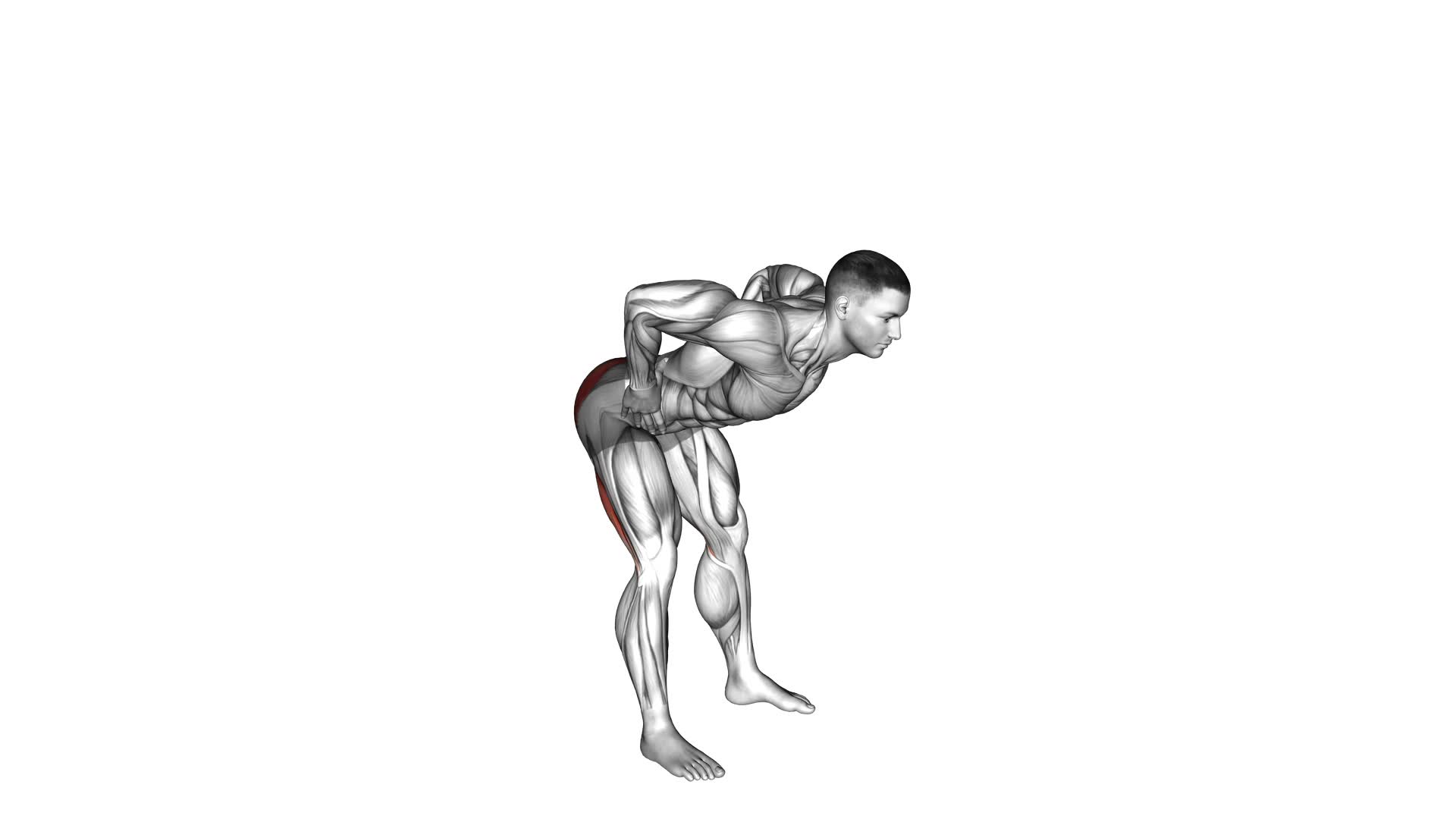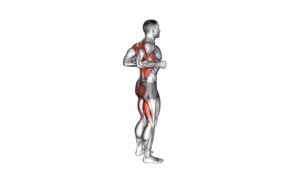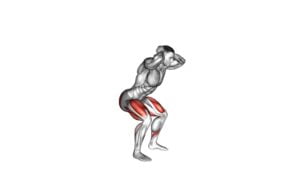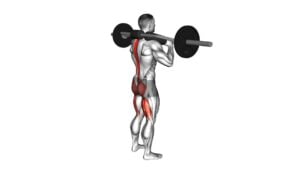Bodyweight Good Morning – Video Exercise Guide & Tips

You're ready to amp up your workout routine and strengthen your posterior chain. Look no further than the bodyweight good morning exercise.
Watch This Exercise Video
In this guide, you'll discover the benefits, proper form, and common mistakes to avoid. Plus, we'll show you how to modify and progress the exercise to fit your fitness level.
Get ready to feel the burn and improve your overall strength with the bodyweight good morning. Let's dive in!
Key Takeaways
- Muscular activation in lower back, glutes, hamstrings, and core
- Improved posture and stability
- Increased flexibility in hamstrings and lower back
- Greater range of motion
Benefits of Bodyweight Good Morning
What are the benefits of incorporating bodyweight good mornings into your exercise routine?
Bodyweight good mornings provide several benefits, including muscular activation and increased flexibility. When performing this exercise, you engage and activate the muscles in your lower back, glutes, hamstrings, and core. This activation helps to strengthen and tone these muscles, leading to improved posture and stability.
Additionally, bodyweight good mornings help to increase flexibility in your hamstrings and lower back. As you hinge forward at the hips and lower your torso towards the ground, you stretch these muscles, promoting greater range of motion. This increased flexibility can translate to improved performance in other exercises and daily activities.
Proper Form and Technique
To ensure proper execution of the bodyweight good morning exercise, it's important for you to maintain the correct form and technique. Proper form is crucial to prevent injury and maximize the effectiveness of the exercise.
Start by standing with your feet shoulder-width apart and your hands either behind your head or crossed in front of your chest. Engage your core and maintain a straight spine throughout the movement.
As you hinge at the hips, imagine pushing your buttocks back while keeping your chest lifted. It's important to avoid rounding your back or allowing your knees to bend excessively. Bend forward until you feel a stretch in your hamstrings, but be careful not to go too far to avoid strain on your lower back.
To return to the starting position, engage your glutes and hamstrings as you push your hips forward and stand tall. Remember to breathe throughout the exercise and keep a controlled pace.
By maintaining proper form and technique, you can reap the full benefits of the bodyweight good morning exercise.
Now, let's move on to the next section and discuss common mistakes to avoid.
Common Mistakes to Avoid
Avoid these common mistakes to ensure proper execution of the bodyweight good morning exercise. By being mindful of these errors, you can prevent injuries and maximize the effectiveness of this workout.
One common mistake is rounding your back during the movement. This places excessive strain on your spine and can lead to back pain or injury. Instead, maintain a neutral spine position throughout the exercise.
Another mistake is using too much weight or resistance. Start with lighter loads and gradually increase as your strength improves. Using excessive weight can compromise your form and increase the risk of injury.
It's also important to avoid locking your knees during the exercise. Keep a slight bend in your knees to reduce stress on the joint and engage the muscles of your lower body more effectively.
Lastly, make sure to perform the exercise in a controlled manner. Avoid jerking or swinging your body, as this can strain your muscles and decrease the effectiveness of the exercise.
Equipment Needed for Bodyweight Good Morning
You don't need much equipment to perform a bodyweight good morning exercise. In fact, all you really need is your own bodyweight as resistance.
This makes it a convenient workout option that can be done anywhere, anytime.
Minimal Equipment Required
You only need a few pieces of equipment for the bodyweight good morning exercise. Here are the minimal equipment required for this exercise:
- A sturdy chair or bench: This will serve as a support for your hands while performing the movement.
- A yoga mat or exercise mat: This will provide cushioning and support for your knees and feet during the exercise.
- Comfortable workout clothes: Opt for breathable and flexible clothing that allows freedom of movement.
- Proper footwear: Choose shoes that provide stability and support to prevent any potential injuries.
These minimal equipment requirements make the bodyweight good morning exercise accessible for anyone, whether you're working out at home or in a gym. By using these items, you can comfortably and safely perform this effective bodyweight exercise to strengthen your posterior chain and improve your overall fitness.
Bodyweight as Resistance
Continuing from the previous subtopic, now let's explore how bodyweight can be used as resistance for the bodyweight good morning exercise.
Bodyweight exercises are a form of resistance training that rely solely on the weight of your own body to provide the resistance needed to build strength and muscle.
The bodyweight good morning exercise specifically targets the hamstrings, glutes, and lower back muscles. By using your bodyweight as resistance, you can effectively engage and strengthen these muscles without the need for any additional equipment.
This makes it a convenient and accessible exercise that can be done anywhere, anytime.
Incorporating bodyweight exercises like the good morning into your fitness routine can help improve your overall strength and stability.
Versatility in Workout Options
To maximize the versatility of your workouts, it's important to consider the equipment needed for the bodyweight good morning exercise. The great thing about this exercise is that it can be performed without any equipment, making it a convenient option for those who prefer bodyweight exercises.
However, if you're looking to add some variety to your workouts or increase the difficulty, you can incorporate the following equipment:
- Resistance bands: Attach a resistance band around your upper back or neck, and hold the ends with your hands for added resistance.
- Dumbbells: Hold a pair of dumbbells in your hands, either by your sides or resting on your shoulders, to increase the intensity of the exercise.
- Barbell: Place a barbell on your upper back, holding it with your hands, to challenge your strength and stability.
- Weighted vest: Wear a weighted vest to add extra resistance to the exercise, making it more challenging and effective for building strength.
Modifications and Progressions
Now let's talk about modifications and progressions for the bodyweight good morning exercise. These points will help you adjust the difficulty level to match your fitness level and gradually improve your strength and technique.
You'll learn about different modifications that can make the exercise easier or more challenging, as well as variations in technique that can help you progress and avoid injuries.
Difficulty Levels for Modifications
As you explore modifications and progressions for the bodyweight good morning exercise, consider the varying levels of difficulty. Different individuals have different fitness levels and abilities, so it's important to choose the modification techniques that are appropriate for you.
Here are four difficulty levels to consider:
- Beginner: Start with a smaller range of motion and focus on mastering the form before progressing to more challenging variations.
- Intermediate: Increase the range of motion and add some resistance, such as holding a dumbbell or kettlebell.
- Advanced: Incorporate unilateral movements by performing the exercise with one leg at a time or adding more weight to further challenge your muscles.
- Elite: Elevate your feet on a step or platform to increase the difficulty and target your hamstrings and glutes even more.
Remember to always listen to your body and choose the modification level that allows you to perform the exercise with proper form and without pain or discomfort.
Technique Variations for Progressions
To progress further in your bodyweight good morning exercise, try incorporating technique variations that can challenge your muscles in new ways.
There are several progression techniques that you can use to make the exercise more advanced. One option is to add resistance by holding a dumbbell or kettlebell in your hands while performing the movement. This will increase the load on your hamstrings and glutes, making the exercise more challenging.
Another variation is to perform the exercise on an unstable surface, such as a Bosu ball or a balance board. This will engage your core muscles even more as they work to stabilize your body.
Finally, you can try performing the good morning exercise with one leg. This unilateral variation won't only challenge your muscles but also improve your balance and stability.
Incorporating these advanced variations into your bodyweight good morning routine will help you continue to progress and see results.
Injury Prevention During Modifications
To prevent injuries during modifications and progressions of the bodyweight good morning exercise, prioritize maintaining proper form and alignment. Here are some tips to help you prevent injuries while modifying exercises:
- Start with proper warm-up: Before attempting any modifications or progressions, make sure to properly warm-up your body. This will increase blood flow to your muscles, making them more flexible and less prone to injury.
- Gradually increase intensity: When modifying exercises, it's important to gradually increase the intensity. Jumping into advanced modifications without proper preparation can lead to injuries. Take your time and progress at a pace that's comfortable for you.
- Listen to your body: Pay attention to any discomfort or pain during the exercise. If something doesn't feel right, don't push through it. Modify the exercise or seek guidance from a fitness professional.
- Use proper equipment: Make sure you have the right equipment for modifications. This includes using stable surfaces, supportive shoes, and any additional equipment needed for balance or stability.
By following these injury prevention tips, you can safely modify exercises and reduce the risk of injuries.
Now, let's move on to some tips for incorporating the bodyweight good morning into your workout routine.
Tips for Incorporating Bodyweight Good Morning Into Your Workout Routine
When incorporating bodyweight good morning into your workout routine, start by setting aside a specific time for this exercise. It's important to allocate enough time to properly warm up your muscles and perform the exercise with proper form.
If you want to add challenge and intensity to your bodyweight good morning, you can incorporate weights into the exercise. This can be done by holding a dumbbell or kettlebell against your chest or on your shoulders. By adding weights, you'll engage more muscles and increase the resistance, resulting in a more challenging workout.
In addition to incorporating weights, you can also try different variations of the bodyweight good morning to target different muscle groups. One variation is the single-leg bodyweight good morning, where you perform the exercise on one leg at a time. This variation helps improve balance and stability while targeting the glutes, hamstrings, and lower back.
Another variation is the banded bodyweight good morning, where you use resistance bands around your hips to add extra resistance to the movement. This variation is great for activating the glutes and hip muscles.
Remember to always listen to your body and start with lighter weights or easier variations if you're a beginner. Gradually increase the intensity and difficulty as your strength and form improve.
Incorporating bodyweight good morning into your workout routine can help improve your overall strength, stability, and posture.
Frequently Asked Questions
Can I Do Bodyweight Good Mornings if I Have Lower Back Pain or Injuries?
If you have lower back pain or injuries, it isn't recommended to do bodyweight good mornings. These exercises can put strain on your lower back and potentially worsen your condition.
However, there are modifications you can try to make it more comfortable.
Alternatively, there are plenty of other exercises that can help strengthen your lower body without putting stress on your lower back.
It's important to consult with a healthcare professional or a certified trainer for advice tailored to your specific situation.
How Many Reps and Sets Should I Do for Bodyweight Good Mornings?
When it comes to bodyweight good mornings, it's important to consider the number of reps and sets you should do.
To determine this, focus on your fitness goals and current fitness level. Generally, starting with 2-3 sets of 10-15 reps is a good starting point. Remember to rest for about 30-60 seconds between sets.
As you progress, you can increase the number of reps or sets, or even try different variations and modifications to challenge yourself further.
Can Bodyweight Good Mornings Help Me Improve My Deadlift?
Bodyweight good mornings can definitely help improve your deadlift. By practicing this exercise, you'll strengthen the muscles in your lower back, glutes, and hamstrings, which are all essential for a strong deadlift.
The proper form for bodyweight good mornings involves hinging at the hips, keeping your back straight, and engaging your core.
Additionally, the benefits of bodyweight good mornings include improved hip mobility and increased overall strength.
Incorporate this exercise into your routine to see improvements in your deadlift.
Are Bodyweight Good Mornings Suitable for Beginners?
Bodyweight good mornings are a great exercise for beginners. They help strengthen your lower back, hamstrings, and glutes. If you're not comfortable with the movement yet, there are alternatives you can try, like using a resistance band or a broomstick.
As you progress, you can increase the difficulty by adding weights or doing the exercise on one leg. Just make sure to maintain proper form and start with lighter weights before progressing.
Can Bodyweight Good Mornings Help Me Improve My Posture?
Bodyweight good mornings can definitely help improve your posture. By performing this exercise without any added weight, you can focus on mastering the proper form and technique. This will strengthen your posterior chain, including your lower back, glutes, and hamstrings, which are all important for maintaining good posture.
Additionally, bodyweight good mornings offer a safer alternative to weighted good mornings, reducing the risk of injury. Incorporating them into your routine can provide numerous benefits for your overall fitness.
Conclusion
In conclusion, the bodyweight good morning is a highly effective exercise for targeting the glutes, hamstrings, and lower back. By maintaining proper form and technique, you can maximize the benefits while avoiding common mistakes.
This exercise requires no equipment and can be modified or progressed to suit your fitness level. Incorporating bodyweight good mornings into your workout routine will help strengthen and tone your posterior chain, improving overall athletic performance.

Author
Years ago, the spark of my life’s passion ignited in my mind the moment I stepped into the local gym for the first time. The inaugural bead of perspiration, the initial endeavor, the very first surge of endorphins, and a sense of pride that washed over me post-workout marked the beginning of my deep-seated interest in strength sports, fitness, and sports nutrition. This very curiosity blossomed rapidly into a profound fascination, propelling me to earn a Master’s degree in Physical Education from the Academy of Physical Education in Krakow, followed by a Sports Manager diploma from the Jagiellonian University. My journey of growth led me to gain more specialized qualifications, such as being a certified personal trainer with a focus on sports dietetics, a lifeguard, and an instructor for wellness and corrective gymnastics. Theoretical knowledge paired seamlessly with practical experience, reinforcing my belief that the transformation of individuals under my guidance was also a reflection of my personal growth. This belief holds true even today. Each day, I strive to push the boundaries and explore new realms. These realms gently elevate me to greater heights. The unique combination of passion for my field and the continuous quest for growth fuels my drive to break new ground.







